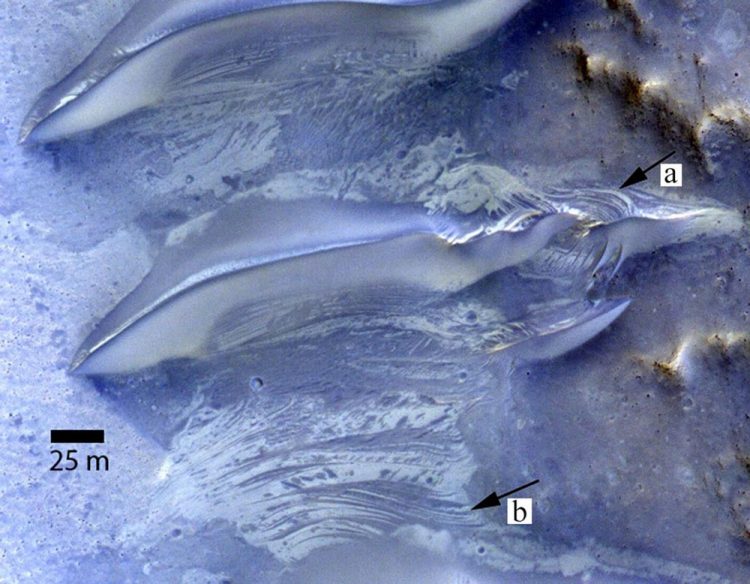Researchers pinpoint watery past on Mars

a) Exposure of putative crossbeds on windward slope of dunes on Mars b) Interdune strata exposed in planform showing contrasting albedo and crosscutting relationships similar to that exposed in the dune. Subset of false-colour HiRISE image ESP_013319_1685. The Infrared, red and blue bands are displayed as red, green and blue. Credit: Dr Mary Bourke (Trinity College Dublin).
The findings have just been published in Geophysical Research Letters, by Dr Mary Bourke from Trinity, and her colleague, Professor Heather Viles, from the University of Oxford.
Dr Bourke said: “On Earth, desert dunefields are periodically flooded by water in areas of fluctuating groundwater, and where lakes, rivers and coasts are found in proximity. These periodic floods leave tell-tale patterns behind them.”
“You can imagine our excitement when we scanned satellite images of an area on Mars and saw this same patterned calling card, suggesting that water had been present in the relatively recent past.”
In a remote sensing study of the Namib Desert, the researchers had previously noted these patterns — 'arcuate striations' — on the surface between migrating sand dunes. Fieldwork subsequently showed that these arcuate striations resulted from dune sediments that had been geochemically cemented by salts left behind by evaporating groundwater. These dune sediments later become relatively immobile, which means they are left behind as the dunes continue to migrate downwind.
Dr Bourke added: “Following our work in Namibia, we hypothesise that on Mars, similar arcuate striations exposed on the surface between dunes are also indications of fluctuating levels of salty groundwater, during a time when dunes were actively migrating down the valley.” ** See Image 2 to visualise this **
“These findings are hugely significant. Firstly, the Martian sand dunes show evidence that water may have been active near Mars' equator — potentially in the not-too-distant past. And secondly, this location is now a potential geological target for detecting past life forms on the Red Planet, which is important to those involved in selecting sites for future missions.”
Media Contact
All latest news from the category: Physics and Astronomy
This area deals with the fundamental laws and building blocks of nature and how they interact, the properties and the behavior of matter, and research into space and time and their structures.
innovations-report provides in-depth reports and articles on subjects such as astrophysics, laser technologies, nuclear, quantum, particle and solid-state physics, nanotechnologies, planetary research and findings (Mars, Venus) and developments related to the Hubble Telescope.
Newest articles

Innovative vortex beam technology
…unleashes ultra-secure, high-capacity data transmission. Scientists have developed a breakthrough optical technology that could dramatically enhance the capacity and security of data transmission (Fig. 1). By utilizing a new type…

Tiny dancers: Scientists synchronise bacterial motion
Researchers at TU Delft have discovered that E. coli bacteria can synchronise their movements, creating order in seemingly random biological systems. By trapping individual bacteria in micro-engineered circular cavities and…

Primary investigation on ram-rotor detonation engine
Detonation is a supersonic combustion wave, characterized by a shock wave driven by the energy release from closely coupled chemical reactions. It is a typical form of pressure gain combustion,…



